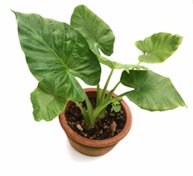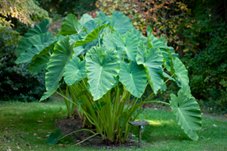Elephant Ear Plant – Bold Tropical Foliage
This large leaf plant belongs to the Araceaea family, and can be planted year round in USDA Hardiness Zones 8B through 11. If you live in a colder climate, this plant can be brought indoors during the winter.
Depending on the species, the Elephant Ear Plant (also referred to as Taro Plant, Alocasia, Calocasia, and Caladium) can grow up to nine feet tall, with a spread of one to ten feet wide.
Taro plant leaves resemble an elephant’s ear; they are heart-shaped and vary in size (1-3 feet long, 1-2 feet across). The evergreen foliage texture and color differs by species; color can be green, purple, or variegated.
Elephant Ear Plants originate from tropical and sub-tropical climates. They grow from tuberous bulbs, and thrive in hot temperatures and high humidity. Their dramatic leaves emerge from the end of stiff stalks that grow in clusters.
Elephant Ear Plant Care - Indoors
Taro plants make a dramatic statement when potted as houseplants, and can be used as a focal
point in tropical interior design themes.
and can be used as a focal
point in tropical interior design themes. Lighting - Choose a location with bright, indirect light. Direct sunlight will cause leaf color to fade.
Temperature & Humidity – Room temperature should be 65°-75° F. Keep away from hot or cold drafts. This tropical plant requires high humidity. If your home is dry, place a potted plant on a tray filled with water and pebbles.
Watering – Keep this plant evenly moist (not soggy) at all times.
Fertilizer – Feed once a month with an all purpose, slow release houseplant fertilizer.
Dormancy – At the end of summer, elephant ear plants go dormant. Cut back leaves as they die off. Move pots to a location that is room temperature (no cooler that 50° F). Shoots will start to grow back in the spring. Resume watering and move pot to a bright location.
Elephant Ear Care - Outdoors
The tropical taro plant is an evergreen perennial that grows in warm, humid climates, and is a
dramatic backdrop for gardens and landscape. Their large, showy leaves
come in a wide variety of colors, sizes, and textures.
warm, humid climates, and is a
dramatic backdrop for gardens and landscape. Their large, showy leaves
come in a wide variety of colors, sizes, and textures.
Elephant Ears can be planted year round in hardiness zones 8B-11. This
plant will thrive when planted in rich, organic soil with good
drainage. Be sure you choose a bright location that receives partial
shade.
Elephant Ear Plants are known to be invasive, so consider planting
bulbs in a confined location (edge with a border, or plant in an above
ground planter). The best time for planting bulbs is spring.
- Dig a hole 2-3 inches deep for small bulbs, 8-10 inches for
large bulbs.
- Place the bulb in the hole – the roots should be facing
down.
- Fill in the hole with soil. Note: Water the plant during
the planting process to prevent air pockets. Keep soil moist during the
growing season.
- If you are planting more than one bulb, be sure to space
small bulbs 12-18 inches apart, large bulbs 36-60 inches apart.
- Fertilize monthly with a slow release, water soluble
fertilizer.
- If you live north of zone 8, dig up the bulbs and store them indoors for over wintering. They can be placed in a box filled with peat moss, and stored in a cool, dry location.





